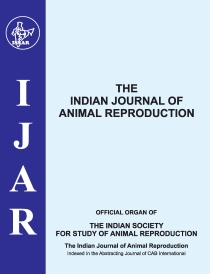APPLICATION OF PROGESTERONE PROFILES IN THE ASSESSMENT OF POST ARTIFICIAL INSEMINATION FERTILITY IN CATTLE
DOI:
https://doi.org/10.48165/ijar.2023.44.01.6Keywords:
Artificial Insemination, Computer application, Cattle, Fertility, ProgesteroneAbstract
The present study was conducted to investigate success of AI in relation to progesterone concentrations with respect to the timing of inseminations or heat detection in the field. Milk samples were collected for progesterone assay from 149 crossbred cows subjected to AI. The milk progesterone concentrations were estimated by RIA to access the reproductive status of the cows. On the day of AI, progesterone concentrations were less than 1.0 nmol/L (Low) in 51% samples and more than 3.00 nmol/L (High) in 18%. Rest 31 % samples showed intermediate progesterone (1.01 to 2.99 nmol/L) suggesting that these cows were nor in proper heat at the time of AI. On the basis of two samples (day 0 and day 10-12 post AI), 50% cows had low progesterone concentrations on the day of AI and high in the second sample, indicating that these cows were inseminated during estrus and ovulated subsequently. Whereas, 12% cows had high progesterone in both the samples suggesting that at the time of AI these cows were either in the luteal phase or had luteal cyst. Remaining 37% cow had intermediate progesterone concentrations on both the occasions suggesting that they were having either developing or regressing or malfunctioning corpora lutea or partial luteal cyst. Perusal of observations on progesterone concentrations showed that 18% of inseminations were done during luteal phase and another 30% were done at some inappropriate time of heat, thus suggesting that high proportion (48%) of cows under field conditions were inseminated while not in proper heat.
References
Adriaens, I., Huybrechts, T., Geerinckx, K., Daems, D., Lammertyn, J., Ketelaere, B. and Aernouts, B. (2017). Mathematical characterization of the milk progesterone profile as a leg up to individualized monitoring of repro
duction status in dairy cows. Theriogenology, 103: 44-51. Dzung, C. A., X, C. L., Ngoc, L. V., Van, C. D., Chung, D. P. and Hai, P. H. (1999). Constraints on efficiency of artificial insemination and effect of nutrition on reproductive per formance of dairy cattle in small holder farms in Viet Nam. Proceedings of a Final Research Co-ordination Meeting organized by the Joint FAO/IAEA Division of Nuclear
Techniques in Food and Agriculture held in Uppsala, Sweden, pp. 67.
Hafez, E. S. E. (1993). “Reproductive behaviour”, Reproduction in farm animals. 6th Edn Lea and Febiger, Philadelphia, 237-257.
Lamming, G. E. and Darwosh, A. O. (1998). The use of milk pro gesterone profile to characterise components of sub fertility in milked dairy cows. Animal Reprod. Sci., 52: 175-190.
Madureira, A.M.L., Burnett, T.A., Borchardt, S., Heuwieser, W., Baes, C.F. and Vasconcelos, J. L. M. (2021). Plasma con centrations of progesterone in the preceding estrous cycle are associated with the intensity of estrus and fertility of Holstein cows. Plos One, https://doi.org/ 10.1371/journal. pone.0248453.
Mongiardino, M. E., Rodriguez, L. and Vinals, D. (1999). Studies on the causes of inefficiency in artificial insemination sys tems in dairy cattle in Argentina. Proceedings of a Final Research Co-ordination Meeting organized by the Joint FAO/IAEA Division of Nuclear Techniques in Food and Agriculture held in Uppsala, Sweden. pp. 79.
Pedroso, R., Roller, F., Gonzalez, N., Flipe, N. and Bravo, M. (1999). Factors that affect the quality and efficiency of artificial insemination in oestrous synchronization pro grammes in dairy cattle. Proceedings of a Final Research Co-ordination Meeting organized by the Joint FAO/IAEA Division of Nuclear Techniques in Food and Agriculture held in Uppsala, Sweden, pp. 111.
Singh, H., Brar, P.S., Singh, N., Jan, M. H., Honparkhe, M. and Dhindsa, S.S. (2020). Effects of intra-uterine infusion of proteolytic enzymes on selected cytokine concentrations,
uterine inflammation, and fertility in postpartum water buf falo with subclinical endometritis. https://doi.org/10.1016/j. anireprosci.2020.106335.
Singh, J., Ghuman, S.P.S., Honparkhe, M. and Singh, N. (2009). Investigations of dominant follicle development, estrus response, ovulation time and fertility in PRID- Treated anestrous buffalo heifers Indian J. Anim. Sci.,79(8): 773-
Singh, N., Nanda, A. S. and Jagir, S. (2008). Assessment of factors affecting conception rate in crossbred cows following arti ficial insemination under field conditions. Indian J. Anim. Rep., 29(2): 211-215.
Than, U., Aung, M. U., Su, S. K. D. and Y, H. W. U. (1999). Improvement of cattle production in Myanmar through the use of progesterone RIA to increase efficiency and quality of artificial insemination services. Proceeding of a Final Research Co-ordination Meeting organized by the Joint FAO/IAEA Division of Nuclear Techniques in Food and Agriculture held in Uppsala, Sweden, pp. 45.
Toleng, L., Sonjaya, H., Yusif, M. and Hamid, A. (1999). The use of progesterone RIA to increase efficiency and qual ity of artificial insemination services of beef cattle in South Sulawesi, Indonesia. Proceeding of a Final Research Co-ordination Meeting organized by the Joint FAO/IAEA Division of Nuclear Techniques in Food and Agriculture held in Uppsala, Sweden, pp. 37.
Yan, L. Y., Robinson, R. S., Shi, Z. D. and Mann, G. E. (2018). Milk progesterone on day 5 following insemination in the dairy cow: associated metabolic variables and reproductive consequences. S. Afr. J. Anim. Sci., 48:2 361-368.




